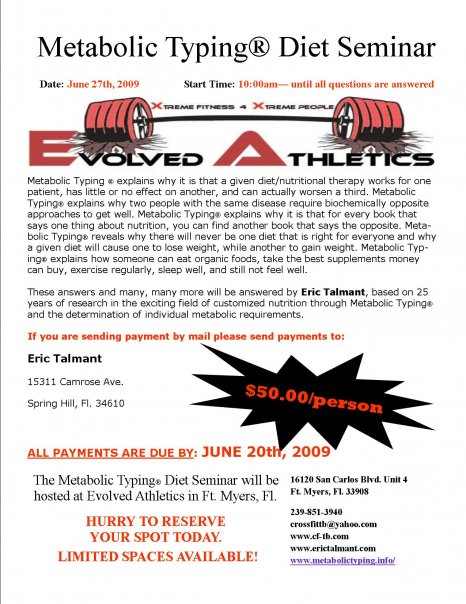|

No two people are alike. Enter Metabolic Typing®, or what I like to call common sense. In the 1930's, Weston Price discovered, by visiting many parts of the world, that there was a link between modern eating habits and the degree of chronic degenerative illness. He also concluded that there was no such thing as a uniform, "healthy" diet. Because of a myriad of variables such as climate, environmental conditions, common food supplies, etc., different cultural and ethnic groups developed different kinds of dietary requirements. (There is a fascinating book about how cultures and the world itself developed that I highly recommend. Please check this footnote if you are interested.)
Over the years, Price's initial research began to turn up more and more clues as to the optimal way to eat for improved health and well being. In the late 70's and early 80's, William Wolcott made a revolutionary discovery proving that the body's Autonomic Nervous System and the oxidative system were connected. This discovery allowed Wolcott to very accurately predict what kinds of foods each person needs to establish a balance between these two aforementioned systems. Once given the proper nutrients, Wolcott was able to show the body's true capacity to regulate and heal itself.
It is all about balancing body chemistry, which is unique for each one of us.
We all process foods and utilize nutrients differently. It is these differing genetic requirements that explain why broccoli may be fine for some of you, not affect some of you, and cause some of you to feel not so good.
In the "average" person, every cell in our bodies is designed to be healthy and effectively carry out its specific job. If our cells are not given the proper nutrients, they can lose the ability to do their specific job, which results in a low production of energy. They also lose the ability to repair and rebuild tissue. Powerlifters and athletes would read this as the ability to recover from training. Sickly ones replace healthy cells, which begins a cascading effect upon your entire body. The worst case scenario is that the cells of an organ become so weak that the organ itself becomes inefficient. A good example is the pancreas and its ability to produce insulin.
We learned that the more insulin resistant a person becomes, the more insulin the pancreas must produce in order to carry out its functions. Eventually the pancreas will not produce enough insulin and the result is that some type 2 diabetics end up having to inject insulin. So rather than focusing on debating macronutrient consumption (protein, carbs, and fats), let's first identify our unique body's proper nutrients. In order to identify these nutrients that our bodies have a genetic need for, we need to first figure out what our needs are.

That is the reason behind figuring out your Metabolic Type.
Remember in the last article when I mentioned the shortcomings of treating insulin, high blood pressure, and cholesterol? We always want to treat the underlying causes, not the symptoms. Stress, illness, lack of endurance in the gym, inability to put on muscle mass or get stronger, high body fat, etc. are all symptoms. What we eat is one of the causes.
Our dietary needs are very much determined by heredity. As stated above, various cultures developed distinct nutritional needs as a result of such things as climate, geographic location, and what kinds of edible plants and animals their environments had to offer. For example, many of the indigenous people who live at or near the equator have a strong hereditary need for diets high in carbohydrates i.e. fruits, vegetables, grains, and legumes. In contrast, the ancestral diets of Eskimos consisted of protein and primarily fat in order to keep themselves warm and allow them to survive.
Enter the United States, where we are a melting pot of many different ethnic and cultural backgrounds. Simply put, because of the endless combinations it is just not possible for most of us to accurately identify what our ancestral diet might be; not to mention that our nutritional requirements are also determined by our lifestyle, environment, activity level, body composition goals, etc. Although important, there are many other factors that identify our nutritional needs. Enter the science of Metabolic Typing®.
Remember the breakthrough that Wolcott discovered between the Autonomic Nervous System and the oxidative system that was mentioned in the opening paragraph? The Autonomic Nervous System (ANS) controls all involuntary activities of the body. Immune activity, breathing, heart rate, digestion, body repair and rebuilding, etc. are just a few of the many functions. It is our auto pilot system, because it keeps us alive without our conscious efforts or participation. As such, it is often referred to as the "master regulator of metabolism". There are two opposing but complimentary branches that make up the ANS, the sympathetic branch and the parasympathetic branch; yin and yang if you will. The sympathetic system controls those bodily functions that pertain to energy utilization such as the adrenals, thyroid, and pituitary.
Thus it is known as the "fight or flight" branch.
 For example, when Togo the caveman is suddenly startled by a T-Rex (or a mugger, as the contemporary case may be), his sympathetic system immediately stops digestion, gets blood out to the muscles, and speeds up his heart rate. The parasympathetic system controls those bodily activities that relate to energy conservation such as repairing and rebuilding, digestion, waste elimination, etc. It is known as the "rest and digest" branch. In most people, one branch has stronger neurological influences over the other, which results in a metabolic imbalance. If the imbalance becomes too great, it was discovered that diseases are more prone to develop. Conversely, if the ANS is in balance (or close to) then health is more prone to be vibrant.
For example, when Togo the caveman is suddenly startled by a T-Rex (or a mugger, as the contemporary case may be), his sympathetic system immediately stops digestion, gets blood out to the muscles, and speeds up his heart rate. The parasympathetic system controls those bodily activities that relate to energy conservation such as repairing and rebuilding, digestion, waste elimination, etc. It is known as the "rest and digest" branch. In most people, one branch has stronger neurological influences over the other, which results in a metabolic imbalance. If the imbalance becomes too great, it was discovered that diseases are more prone to develop. Conversely, if the ANS is in balance (or close to) then health is more prone to be vibrant.
Researchers Francis Pottenger and Royal Lee discovered that people have many different physical, psychological, and behavioral characteristics that match up with either sympathetic or parasympathetic dominance. In addition, certain foods and nutrients have the ability to strengthen whichever side of the ANS is weaker (Wolcott's aforementioned colossal discovery) , but I am getting ahead of myself.
herefore, with the help of all these factors, Metabolic Typing enables us to identify which system is more dominant and then recommend those foods that will be more likely to establish balance. Since the ANS is the master regulator of metabolism, proper food recommendation is very important and pretty cool, huh?
While the ANS is concerned with the upkeep and regulation of energy, the oxidative system concerns the rate at which food and nutrients are converted to energy within the body. It involves three important processes:
- Glycolysis
- Beta Oxidation
- Citric Acid Cycle/Krebs Cycle
Roughly one-fifth of the energy created from our food comes from the oxidation of carbohydrates in a process known as glycolysis. Glycolysis is the metabolic breakdown of glucose and other sugars that release energy in the form of ATP (Adenosine triphosphate). The other four-fifths come from the Citric Acid Cycle or Krebs cycle. Simply, energy is produced in the Krebs cycle from a combination of the right amount of oxaloacetate (from the oxidation of carbohydrates in glycolysis) and the right amount of acetyl coenzyme-A (from the metabolism of fats in a process known as Beta-Oxidation).
Simply, glycolysis concerns the metabolism of carbohydrates.
Beta-oxidation is involved in fat metabolism. These two components produce energy in the Krebs cycle, and they are needed in the right amounts. If there are too much oxaloacetate and not enough acetyl coenzyme-A, or vice versa, then energy production will be lacking. This determination of how our bodies execute energy production is known as cellular oxidation.
In 1981, George Watson published Nutrition and Your Mind. After extensive study, he came to the conclusion that biochemical imbalances were at the root of many psychological problems. He accidentally discovered that certain foods and nutrients increased adverse emotional states in some people, while the same foods and nutrients could lessen emotional problems in others. Again, different people required different foods to promote health and wellness. Instead of using the ANS as the basis for classification, he used cellular oxidation. (Now that we know what it is and how it works, we can follow Watson's process.) He conclusively discovered that there is a direct and profound correlation between a person's emotional and psychological characteristics and the rate at which their cells convert food into energy. He observed that some people burned food too slowly, while others burned it too quickly.
 More importantly, this rate of cellular oxidation, which is determined by heredity and environmental influences, can be significantly altered by diet. Here was another piece of the puzzle in balancing body chemistry, which is conducive to optimum health and wellness. Now we need to figure out whether you are a slow oxidizer, a fast oxidizer, or a mixed oxidizer by determining which characteristics (individual to you) apply to each.
More importantly, this rate of cellular oxidation, which is determined by heredity and environmental influences, can be significantly altered by diet. Here was another piece of the puzzle in balancing body chemistry, which is conducive to optimum health and wellness. Now we need to figure out whether you are a slow oxidizer, a fast oxidizer, or a mixed oxidizer by determining which characteristics (individual to you) apply to each.
Fast oxidizers depend too much on the oxidation of carbohydrates in glycolysis for energy production. They have a tendency to burn carbohydrates too quickly, which results in an excess production of oxaloacetate (explained above). Obviously, a high carbohydrate diet will only make the problem worse. However, since proteins and fats are dietary sources of Acetyl Co-A, which is lacking, they will help stimulate and sustain beta-oxidation, which is needed. This will help balance the body chemistry and stabilize energy production.
Like fast oxidizers, slow oxidizers have the same problems with energy production, but for the opposite reasons. They are poor at carbohydrate oxidation in glycolysis and thus are inclined to be lacking in the production of oxaloacetate. In their case, a higher carbohydrate diet will benefit the slow oxidizers by giving them dietary sources for oxaloacetate. Since they also require lower amounts of Acetyl Co-A to balance their body chemistry, as well as different nutrients to stimulate and sustain glycolysis, slow oxidizers benefit from a diet that involves less protein and fat than the fast oxidizer.
Mixed oxidizers are not that complicated. Because of their "balanced" oxidative systems, proper energy production comes from relatively "equal" amounts of protein, carbohydrates, and fats.
Each oxidizer requires different types of foods and different mixes of those foods in order to optimally and efficiently convert nutrient into energy. With sufficient available energy, your body's cells can properly carry out their genetic roles of repairing and reproducing maximally. For example, let's say that you are a slow oxidizer but you are not eating sufficient amounts of carbohydrates. Some of your food will not be converted to energy and will become prone to being stored as fat. You will probably experience fatigue and hunger following meals, as well as indigestion and a lack of stamina. Finally, your body's immune system will become weakened and you will be susceptible to colds and infections. Being sick is certainly not my cup of tea.
Now we understand the Autonomic Nervous System and the oxidative system.
These are the key homeostatic systems that determine our metabolism or our Metabolic Type®. However, the fun is just beginning! We have defined these two big powerhouses that influence our metabolism, but how are we to know which system is more prevalent? We will discuss system dominance, and the three actual Metabolic Types in the next article. We will also finally discuss macronutrient ratios for each type, as well as some fascinating stuff on exactly how a single food can alkalinize the chemistry of one person, while acidify the body chemistry of another. We will also discuss which specific foods are optimum for each type and why. Sit tight, as the rubber is about to meet the road…
References
- William Wolcott and Trish Fahey, The Metabolic Typing® Diet
- Jared Diamond, Guns, Germs, and Steel; The Fates of Human Societies
- Wolcott & Fahey, The Metabolic Typing ®Diet
- Jared Diamond, Guns, Germs, and Steel; The Fates of Human Societies
- Jared Diamond, Guns, Germs, and Steel; The Fates of Human Societies
- Jared Diamond, Guns, Germs, and Steel; The Fates of Human Societies
- Wolcott & Fahey, The Metabolic Typing ®Diet
- Wolcott & Fahey, The Metabolic Typing® Diet
- Glycolysis. (n.d.). Dictionary.com Unabridged (v 1.0.1). Retrieved October 30, 2006, from
Dictionary.com website: http://dictionary.reference.com/browse/glycolysis
- Oxaloacetate. (n.d.). On-line Medical Dictionary. Retrieved October 30, 2006, from
Dictionary.com website: http://dictionary.reference.com/browse/oxaloacetate
- Healthexcel's Metabolic Typing® Assessment; http://www.healthexcel.com
- Wolcott & Fahey, The Metabolic Typing® Diet

Return To Eric Talmant's Author Page
Follow Eric's Training Log
More Nutrition Articles
|